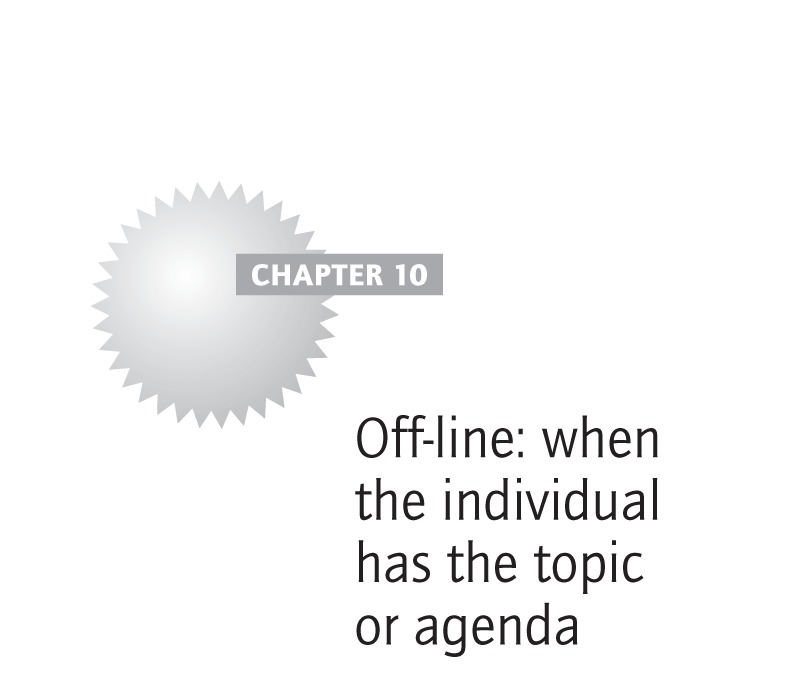Let’s imagine that one of your team wants to talk to you about something and they want to do it away from the workplace. Perhaps they’re struggling with an issue or are frustrated about a situation and want to discuss this with you. It may be something apparently trivial, like a minor concern about a deadline, or something more significant, such as a crisis of confidence. It may be a fairly brief conversation, for example 20 minutes, or something that lasts much longer, perhaps several hours.
The Coaching Path
For all three off-line scenarios, we’re going to use one basic structure, The Coaching Path. This is illustrated in Figure 10.1.
While the Coaching Path has five stages, the first and last stage will already be familiar to you. These stages are simply about beginning and ending a conversation. We’ll explain these in brief to make sure you feel comfortable about opening and closing the session. The key stages that distinguish this conversation as a coaching conversation are the middle three stages, which we’ll cover a little more thoroughly.
Let’s now use the Coaching Path to help you navigate an off-line coaching conversation.
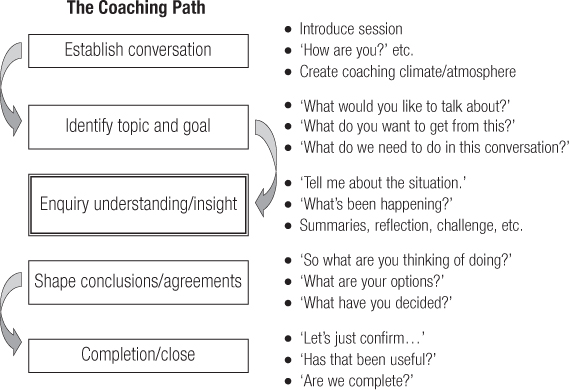
Figure 10.1 The Coaching Path
![]()
Off-line: key coaching principles
Here’s a quick reminder of the key principles that support an off-line coaching conversation.
- This is an ‘adult-to-adult’ conversation, i.e. you are both mature and equal in the conversation.
- The other person is responsible both for the issue they are surfacing and for their actions in relation to that issue – not in a ‘blame’ sense, but simply because they are empowered to think and act.
- The other person owns the agenda, i.e. they know what they want to discuss and also what they want to get out of the meeting.
- The other person probably has their own solution to the situation, or can be challenged to create a way forward for themselves.
- You add value to the conversation by facilitating their thoughts and ideas, using effective questioning to provoke thought and also offering your observations and feedback.
- Although you might have advice you could offer, you prefer that they come up with solutions. You’re prepared not to give answers until it becomes silly not to. Even then, you’ll make ‘gentle offers’, for example ‘Can I offer a thought?’
Stage 1: Establish conversation
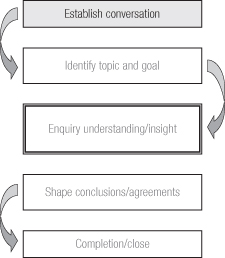
This step is about creating an appropriate sense of the conversation, for example ‘We’re here to discuss a work-related topic’. Remember, it’s a conversation of equals, rather than a meeting with the head of school, so think about how to adopt an ‘adult-to-adult’ posture and tone. Remember the importance of rapport and warmth. You aim to create a relaxed yet professional tone to the conversation that enables the other person to feel comfortable and speak freely. This is balanced with a clear sense that this topic is important to progress efficiently, so you’ll create a sense of leadership, without being controlling. Your colleague must be comfortable that you can navigate through the stages of the conversation, i.e. you know what you’re doing. That will be clearer as we go along. So to summarise, your objectives at this stage include to:
- build appropriate levels of rapport, to help the other person feel comfortable and to encourage natural conversation
- create the appropriate climate for the conversation, for example professional warmth
- create a sense of trust in you, i.e. they are in safe hands.
The following dialogue begins an off-line coaching conversation between Sally and her manager. As we’ll use this conversation to illustrate each stage of the Coaching Path, you might like to imagine yourself as the manager.
As you can see, the manager is simply greeting the team member in an appropriate way, and when it feels natural, moving the conversation on to the task at hand. In all these examples I’ll reduce the dialogue as much as possible, to stick to the key points. In real life your conversation would likely contain more small talk or general chat, but it’s less helpful here.
Stage 2: Identify clear topic and goal
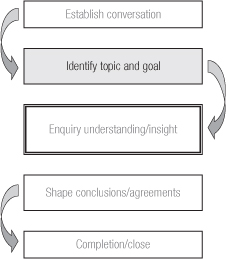
This next stage creates a sense of direction and purpose for the conversation, so that as the coach you know where you need to be heading. Remember, we’re in a conversation where the colleague/subordinate has the objective for the conversation, so the manager needs to identify the objectives for the conversation from what their colleague says. So your objectives at this stage include to:
- encourage your colleague to ‘own’ the session by declaring what they want to get from it
- identify the purpose and topic for the session in sufficient detail to enable you to facilitate the conversation towards an effective outcome
- establish the conditions of an effective conversation, for example we’ll know when we’re on track and when we’ve wandered into a pointless digression
- create a sense that ‘success is possible’ or a ‘solution focus’, i.e. we’re here to work something out and this is where we will get to
- identify an ‘end point’ for the conversation, i.e. know when you’ve met the objectives.
Here you are surfacing your colleague’s topic for discussion and also their goal for the conversation. That might be something fairly easy for you to do, for example if they are well prepared and feeling clear. Or it might be something you need to help them get clear about before you can begin an effective discussion. It’s worth mentioning that you have an important balance to maintain at this point. That balance is between being effective and not frustrating the person in front of you, who might be eager to launch into a topic that they want to get off their chest. At this stage you need a ‘star to guide you’ rather than an exhaustive detailed description of their agenda.
The following dialogue maps the stages between a goal that is too vague and one that has just enough clarity for you to navigate forwards.
| Manager | So, what would you like to talk about? |
| Sally | Well, it’s the whole situation with the team and recruitment we’ve got right now. To be honest, it’s beginning to be a real concern. |
So here you have a vague (broad) topic and not much of a goal for the conversation. While Sally is likely to be ready to begin talking about her ‘problem’, the manager probably needs to push back a little, and gain a little more focus on the conversation. For example:
| Manager | Okay, specifically what is it in regard to the team and recruitment you want us to talk about? |
| Sally | Well, it’s just the delays we’re getting with hiring; it’s taking too long to bring people on board and the work is piling up. |
So now we’re clearer about the topic for the conversation, but we still have no goal to work towards. Depending on how Sally seems – for example calm, flustered, frustrated, etc. – you may decide that you need to proceed to the next stage (enquiry and understanding) to allow her to speak. Your risk is that the conversation will simply become a ‘complaining session’, where Sally explains the situation to you in the hope that it will simply get solved in some way (by you perhaps?). So let’s risk a further challenge.
| Manager | Right, so that’s what we need to work through. Thinking about the next 30 minutes, what do you want to get out of this conversation? |
| Sally | Well, I guess I want to tell you about what’s been going on, and maybe get some ideas as to what else I can do. |
Notice how the responsibility for the conversation and its outcome is still firmly with Sally. The manager is working to maintain rapport and show support – ‘That’s what we need to work through’ – while still encouraging Sally to own the conversation. For some managers this will be a challenge, as they may judge this lack of involvement by themselves as unhelpful. Actually, in the longer term it’s more helpful to Sally, as she learns to solve life’s problems and feel confident about doing that. If at any time as a manager you need to step in and rescue someone, you can. But remember that when you rescue someone you make a victim out of them in the same moment. When we are a victim we feel less powerful, as if something is happening to us. A more powerful posture to act from is the assumption that we are the cause of our experience and are able to change that experience ourselves. As a manager you encourage others to adopt a more powerful posture by assuming that they are able to make a difference in their circumstances themselves (without the need to be rescued).
Back to our Sally scenario; now that we have both a topic and a goal for the conversation, we can progress to the next stage: enquiry understanding and insight.

Ask people to arrive prepared
Your regular one-to-one meetings with subordinates are easier to coach when they work from the idea that what they get from those are largely up to them – for example that they prepare a clear sense of objective or purpose. So ask them to arrive with topics they want to discuss and also some objectives for each topic, or perhaps even send you an agenda ahead of the meeting. It’s a great way to get people acting more powerfully. When they arrive for a conversation prepared, they also begin from a more mature posture, for example ‘Here’s what I want to get from my time with you’, instead of ‘Oh, I thought we’d just chat some stuff through and see what happens’.
Stage 3: Enquiry, understanding and insight

This is perhaps the most important stage in our Coaching Path, as it is where your core coaching skills come into play. It is also the heart of a coaching conversation, where your effective listening, questioning and observations or challenge enable the person to surface their thoughts and arrive at their own conclusions and decisions. The simple process of enquiry, i.e. being listened to, is also therapeutic as we are given space to get things off our chest and perhaps feel better for having expressed emotions such as confusion or frustration. Your key objectives at this stage are to:
- surface a mutual understanding of the situation, issue or challenge (for example, what is the issue, what’s causing the issue, what’s important about the issue?)
- increase the self-awareness of the individual, in relation to the situation being discussed (for example, how might they be affecting the situation?)
- help the other person reflect objectively on the situation (for example, express confusion or frustration) and then move on to a more impartial, balanced view
- help the person form conclusions, realisations or insights arising from clearer thinking
- create more of a focus towards solution (for example, what would be better than this, or how do you want this situation to be instead?).
In our conversation with Sally, here’s how the process of enquiry might sound. Again, I’ve reduced the conversation right down to keep it simple to read.

Your intention is to understand (not to ‘fix’)
When as a manager we coach, our enquiry has the intention to create mutual understanding rather than to help us fix, solve or instruct the other person. While enquiring merely to understand may seem like a pretty pointless task, it is actually where the magic of coaching reveals itself. When someone is asked to paint a proper picture of their own issue or challenge, they can often think more clearly and rationally as a result. As they speak, they form realisations about the situation and also about themselves in relation to that situation. This clarity of perception is likely to lie hidden otherwise. It’s as if you declutter someone’s thoughts for them – from a clearer perspective they can make more sense of their situation. Sometimes we just need to empty our heads of confused static so that a clear signal can be heard!
As you can see, the manager is gently building the facts of the situation, getting clear and helping Sally to focus on the key facts. The manager is also demonstrating empathy (‘I can see why you’d want to tackle this now’) to acknowledge her concern. Let’s continue.
| Manager | So, what have you already done about this? |
| Sally | Well, I’ve been chasing HR about it, as they seem to hold all the cards. I spoke to them yesterday and they still hadn’t set a date for their first interviews. |
| Manager | First interviews? |
| Sally | Yes, they like to do the first round of vetting candidates before they get to us. Once they’ve seen people they pass them over to us. |
| Manager | So where are they in that process? |
| Sally | Well, apparently they’ve got at least three candidates they think we’d be interested in, but they still haven’t arranged to see them. |
So by now your problem-solving skills may have leapt into gear and you think you’ve spotted a solution, i.e. remove the ‘blocking factor’ of HR and get Sally to interview the candidates first.
But remember, you are committed to Sally’s ability to come up with her own way forward. Plus there may be more information you need to hear, before you jump to a conclusion.
Notice how the manager uses a gentle summary with positive effect, before continuing to enquire further. We now have a fuller picture and one that is useful to surface. If the manager had acted on a ‘fix-it’ instinct earlier, their ‘simple solution’ (remove HR from the process) may have been rejected as an impractical suggestion. And remember, it’s Sally who will benefit the most by finding her own solution. Let’s continue.
As you can see, the conversation has taken a slightly different turn, now Sally has got clearer. You’ll also notice that the conversation has gone from one with no sense of possibility (‘It’s a mess’) to having more sense of a potential solution (‘I need to see what’s possible’).
Now that we have a clearer picture of both the issue and Sally’s options, we’ve fulfilled the enquiry stage of the Coaching Path. So let’s go to the next stage.

Don’t withhold information (that’s not coaching)
While the manager should avoid giving quick solutions, if they know of any information that is relevant to a subordinate’s issue then they need to declare it – for example ‘Did you realise that Marketing are making people redundant?’ We don’t want to withhold information; we simply want to reduce our influence on someone’s decision-making process. Remember, you can’t coach knowledge, i.e. if someone doesn’t know the capital of Bolivia it’s pointless to ask them for that.
Stage 4: Shape conclusions and agreements

Here we want to start to pull the conversation together and help Sally shape her ideas into an appropriate way forward. In any coaching conversation the appropriate way forward may range from an agreed set of actions with timescales to a much looser plan of ‘go and have a think’. As coach you can decide on how much rigour and detail to encourage, according to both the topic that has been discussed and also the individual with whom you are discussing it. For example, when you know the other person is a mature individual able to act upon commitments, then if they say ‘I’m going to go away and look at the figures – I’ll get back to you’, that may be enough. Or if the topic of the conversation has been highly personal (for example, ‘Am I in the right job?’), then an agreement to ‘go away and think’ may be very appropriate. But if what you’re discussing is time-related or you need clarity, then ‘I’ll come back to you on Friday morning by 9 a.m. with the document’ might be needed.
So in this fourth stage of shaping conclusions and agreements, your objectives are to:
- provide a useful summary of where the individual has reached, i.e. their conclusions and ideas
- help the individual to surface any remaining conclusions or ideas that are useful
- help the person to decide on a way forward, for example actions, next steps, etc.
- challenge any false barriers or limited thinking
- create a sense of a better future (for example, how will this benefit you?) and so motivate the person to act.
Let’s continue our scenario with Sally.
So you’ll notice that the manager is happy to support Sally to pursue the short-term ‘fixes’ but also wants to challenge the remaining issue of what happens longer term. I’ll add that because the manager has been in the role of coach or facilitator for the conversation, this apparent oversight is actually very easy to spot. Because the manager hasn’t been trying to ‘figure things out’ or create ideas, they are able to maintain a much clearer view of the conversation. Let’s see how this continues.
So again you can see the manager is using a ‘light touch’ to help Sally plan her own way forward. In reality the manager may decide that for the sake of clarity they want to summarise the three actions (Margaret, Marketing and HR), or indeed offer further challenges or observations. But for the purposes of this example, let’s assume the manager is comfortable that Sally has her way forward. We’re ready to go to the final stage: completion and close.

What if someone gets ‘stuck’ when you ask them for solutions or ideas?
First, stay calm, relaxed and focused and use your breathing to stay calm and centred. Your best response to someone who appears stuck will depend on what’s causing their ‘block’. It could be a number of reasons:
- They need reflection time – a period of gentle silence helps.
- They need a more general question, for example ‘What are your options?’ or ‘What thoughts are you having now?’
- They are confused or overloaded. A gentle summary from you can give them a ‘rest’. In extreme cases, offer them a break or even reschedule.
- You haven’t surfaced enough information yet. Backtrack – for example ‘Okay, I’ve heard you say that long hours, plus the travelling, are the real issue – can you say a little more about that?’
- They don’t believe there’s a solution. Use a question that encourages a sense of possibility, for example ‘You’ve said you want to sort this – what would “sorted” look like for you?’
- Sometimes, you’ll know that they are unlikely to think of anything. Before offering your ideas, you still have other options.
- Make a gentle observation, without being too directive. For example, ‘You’ve said that it’s out of your control and also that your boss is rarely around – I’m wondering how those two are linked?’
- Acknowledge the situation. For example, ‘Okay, I may have led us up a dark alley, shall we pause a while? What would you like to do?’
Above all, stay relaxed, and easy-going or flexible. An uptight, frustrated coach flounders, while a calm, resourceful coach creates progress. Trust yourself and trust the process!
Stage 5: Completion and close
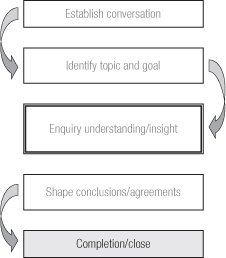
Just like opening the conversation, this stage is one you’re already equipped to deal with, as it’s simply a professional close to the discussion. Here, you create a sense of completion and also a momentum forward. You may need to refer back to the original objectives for the session, if there were several of them, just to check that everything’s been covered. Your key objectives at this stage are to:
- confirm that the conversation is complete and that the other person is happy to close
- indicate that progress has been made
- create mutual clarity as to what happens now
- leave your colleague feeling supported as they go forward
- close the session in a natural way.
Nearly there! Let’s see how this conversation might be drawn to a natural close.
So the manager is gently rounding off the conversation in a warm and supportive way. I hope you can imagine yourself doing something similar. At no time has the manager had to launch into instruction; they have surfaced the thoughts and views of another person. Of course, it’s a convenient scenario as Sally seemed intelligent and mature for most of the conversation. Here I wanted to show you the basic sequence, rather than exceptions to the sequence. For tackling tougher character types, see the brilliant tip box below.

What if someone isn’t open to being coached?
Occasionally the person you are with may appear confused or less confident in a coaching style of conversation. It may be that you encounter someone who seems less open, or just plain difficult! Remember also that as you learn to behave differently in conversation, that will take time and the issue may actually lie with you. To help you decide your best response, check the following.
1. Where someone is less clear or less confident
Here they may feel uneasy with an increased focus on them, their thoughts and ideas. So help them relax as you slow down, breathe, (smile!), reduce the pressure and give them time. Summarise the situation as you see it, make an observation or offer a thought. Add your own imperfect musing, for example ‘So I guess I’m thinking . . . ’ but hold back on specific ideas or instruction for a while. See also the earlier brilliant tip in this section ‘What if someone gets “stuck”?’
2. Where it’s your issue, because you’re struggling with the coaching principles and behaviours
Here the other person may seem confused by the conversation, perhaps because your approach is different from usual. As always you have options:
- Overt: Tell them what you’re attempting/learning to do and ask that they help you to keep the principle of being less directive. Then go back to the basics, for example ‘Okay, so if we operate from a principle that you know enough to figure out the best way forward, and my job is to help you think through the situation – what do we need to talk about here?’ Ask them to help you form effective questions (yes, that can work!). Clearly this option assumes that you are confident in the level of mutual support between you and the other person.
- Covert: Go back to basics. Keep a note of simple questions and phrases and pick one or two. For example,
- To keep me clear, can you just summarise the situation for me again? (This also gives you thinking time.)
- Okay, so what’s the real issue that we need to solve?
- And what needs to happen going forward?
- What are our options here then?
- If you could change one thing about the situation, what would it be?
For other examples of simple coaching questions, see Chapter 7 – ‘Effective questioning’.
- Revert: Stop trying to coach and go back to your normal style and approach. Afterwards, reflect on what worked and what didn’t. Decide what you’re going to do differently next time. Remember, everything is progress and your intention to learn greater flexibility and skill is actually all you need now.
3. Where someone is being difficult or less open
Perhaps they give you overly short answers, or appear reluctant to respond helpfully to questions. Again, you have options:
- Stay calm and continue: Act as if they aren’t being difficult (sometimes they’ll simply relax and let go of their own resistance). See option 1 earlier for a way to do that.
- Point at the behaviour: By this I mean make a gentle observation of what you’re doing and how you’re experiencing their response. For example, [soft tone] ‘Okay, so what I’m trying to do is understand your thoughts about this situation as I’m guessing you have some value to add here. Now from your responses it seems you don’t feel comfortable doing that. How fair is that please?’ From their response you can decide to continue seeking to understand their reaction (and support them to relax and talk more freely) or go to option c below.
- Decide not to deal with it right now: Switch back to a more directive style and approach (as in option 2c above). Remember that you don’t have to stay in a directive style and can flex back to a less directive style at any point. For example, making observations, and giving summaries might work later in the conversation. See also Chapter 8 (‘A flexible style of influence’) for ideas.

